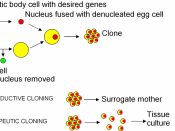ANIMAL CLONING
The advances to the biotechnology of animal cloning are very important to scientific technology and medicine today. Animal cloning is the production of one or more individual animals that are genetically identical to another individual animal. The most famous type is adult reproductive cloning, involving the duplicating of an existing animal. This process begins with removing cells of the first animal (the genetic mother) and extracting its nucleus and DNA. Then, the nucleus of an unfertilized egg cell of the second animal (the surrogate mother) is removed and replaced with the nucleus of the genetic mother. The two cells are fused together artificially using a small electric charge. The result, an artificially fertilized egg cell, is then cultured in the laboratory and implanted into the birth mother. Finally, a cloned offspring is born. Another main type of animal cloning is embryo cloning where one or more cells are removed from a fertilized embryo in order to develop into one or more duplicate embryos.
The product is twins or triplets with identical DNA.
There are many advantages, benefits, and uses of this biotechnology. One important example is xenotransplantation, which is genetically modifying animals so that they can grow organ transplants for humans. This has been performed using pigs, and is extremely helpful since there is not enough available human donors for people who desperately need transplants. As well, cloning of animals helps in potential applications of improving human health care such as heart disease, diabetes or liver failure. For instance, medical experimentation on the effectiveness of a drug using genetically identical test subjects would produce more accurate and clearer results since there is more consistency. Future potential usage includes increase to the food supply and breeding of more species of endangered animals. Unfortunately, some hazards are present when...



One thing...
Using Hence to start a paragraph sometimes means that the two are closely related and might just as well stay one paragrah, good job though!
8 out of 8 people found this comment useful.